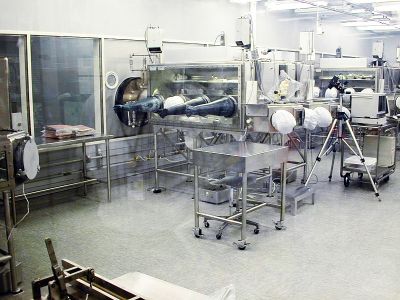GAM 2019 Blog
by Kelly Beatty
- Published: Thursday, April 11 2019 03:03

Part of the cleanroom lunar sample processing arrangements, showing the work areas, glove boxes and other provisions for avoiding lunar sample contamination at the Lunar Sample Building, Johnson Space Center, Houston, Texas
That’s how Harvard geologist Clifford Frondel described the rocks returned from the Moon by Apollo 11’s astronauts. Frondel was among a quartet of scientists chosen to make the first quick assessment of the samples’ appearance once they arrived at NASA’s Manned Spacecraft Center in Houston. But he was frustrated to find that the rocks were still covered by a thick, dark coating of lunar dust.
Studying the rocks in detail was not easy at first. They were stored in a $7-million vacuum enclosure that proved difficult to work with. NASA had it built to protect the specimens from Earth’s environment and to prevent contamination from any alien organisms that might have stowed away during the astronauts’ return.
To get at the Moon rocks, technicians stuck their arms into the airtight enclosure through portholes outfitted with the sleeves and gloves from spacesuits. However, scientists soon realized that the lunar samples carried no life forms whatsoever, and the clumsy vacuum system was abandoned in favor of simpler methods.
The six Apollo crews who landed on the Moon came back with a total of 481 pounds of rocks, dust, and samples obtained by drilling several feet into the surface. Between 1970 and 1976, three automated craft from the Soviet Union also returned small scoops of lunar material.
Today the bulk of this treasure trove is still housed by NASA in Houston, though about 14 percent of the collection has been stashed for safekeeping at an Air Force base in nearby San Antonio. The samples themselves are stared in vaults with reinforced concrete walls, a foot-thick steel door, and an atmosphere of pure nitrogen gas.
Visitors to the storage facility encounter a scene reminiscent of hospital surgery rooms. Technicians wear caps and gowns, and they never touch the samples with anything that could contaminate their surfaces. The storage containers are made of Teflon and stainless steel.
Ordinary hand tools cannot be used because they contain minute traces of elements like lead, which can be transferred to the rocks’ surfaces and later throw off the results of extremely delicate measurements. NASA geologists have subdivided the original 2,196 numbered samples into about 70,000 pieces, each of which is carefully documented. At any given time 700 to 900 bits of lunar material, some weighing only a thousandth of an ounce, are being analyzed in the world’s research laboratories.
Surprisingly, to date only about one-fifth of the samples have been looked at in detail, But from them a great deal has been learned about the birth and evolution of the Earth’s companion.
Before they had the Apollo samples to work with, planetary scientists were divided in their opinions about the Moon’s characteristics.
Some space theorists thought the Moon formed in relative cold, accumulating slowly from gas and dust present in the primordial solar system. These “cold Mooners” believed the lunar surface would turn out to be virtually the same today as when it formed billions of years ago. The dark lunar maria, or “seas,” they predicted, would be vast blankets of carbon-enriched dust.
Others thought that the Moon’s interior had once been very hot, and that the dark maria were huge outpourings of lava. Through a telescope, the maria appear far less cratered than other parts of the Moon are. They were thought by the “hot Mooners” to be rather young, geologically speaking.
The Apollo 11 crew landed on what is called the Sea of Tranquility, and the rocks they brought home were indeed volcanic. Tests showed that the samples’ ages fell between 3.8 and 3.1 billion years, but that the Moon as a whole formed when the Earth did, about 4.6 billion years ago.
By the time the last Apollo crew returned from the Moon in December, 1972, scientists had found that the lunar samples contained absolutely no water and had other compositional characteristics that made them quite distinct from terrestrial rocks.
Researchers were also surprised to learn just how much the Moon’s surface had been pummeled by interplanetary debris. In fact, many of the rocks were nothing more than a collection of stony fragments that had been fused together by shock and heat during such impacts.
Perhaps the single greatest finding has been that much of the Moon — if not its entire globe — was molten early in its history. This “magma ocean” caused minerals to form that are virtually unknown on Earth. According to the late Graham Ryder, who had been a geochemist at Houston’s Lunar and Planetary Institute, “Even the ‘hot Mooners’ didn’t anticipate the degree of melting that the Apollo samples imply.”
In the end, the Apollo expeditions did not answer the basic question, “Where did the Moon come from?” But they did narrow the possibilities enough to rule out some theories altogether.
Today, many scientists suspect that the Moon formed due to a collision of cataclysmic proportions. They argue that a maverick world the size of Mars careened into the infant Earth. The impact released enough energy to propel an enormous “splash” of molten and vaporized rock into space, which later cooled and formed the Moon.
While this scenario fits many of the pieces of evidence found in the Moon rocks, it is considered far from certain. Lunar specialists agree that only by returning to the Moon for further study will we learn, once and for all, where it came from.
| J. Kelly Beatty, Sky & Telescope Senior Editor, joined the staff of Sky Publishing in 1974 and specializes in planetary science and space exploration. Learn more about him here |  |






